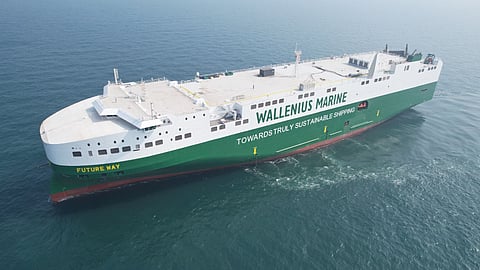VESSEL REVIEW | Future Way – Wallenius Lines' newest car carrier with efficiency-enhancing features
Swedish shipping company Wallenius Lines recently took delivery of the first vessel in a new series of pure car and truck carriers (PCTCs) built by CIMC Raffles of China. Future Way was designed jointly by Wallenius Lines subsidiary Wallenius Marine and Danish naval architecture firm Knud E. Hansen in compliance with DNV class rules.
Prominent aerodynamic hull
“This belongs to the Sleipner concept, which is a concept with high-capacity workhorse vessels that are also energy-efficient,” Dan Reineck, Project Manager with Wallenius Marine’s Ship Design, Newbuilding and Innovation division, told Baird Maritime. “We wanted a ship with its fuel consumption as low as possible and as little ballast as possible. In this particular case, the ship was designed to satisfy the requirements of our customer, the Volkswagen Group, which wanted a vehicle carrier with a capacity of 6,500 cars.”
The PCTC has a length of 199.95 metres (656 feet), a beam of 37 metres (120 feet), a draught of 9.5 metres (31 feet), a depth of 13.4 metres (44 feet), and an aerodynamically optimised bow that can reduce wind resistance. Reineck said that cargo hold fans have also been installed to generate as little wind resistance as possible. The upper hull and the superstructure were also designed to have as few protruding parts as possible, which can help minimise fuel consumption.
A number of features have also been incorporated to reduce the vessel's environmental footprint and thus eliminate the need for it to carry any ballast water when fully loaded, and transatlantic crossings are possible even in this configuration, thus reducing the risk of the spread of invasive species. The structure has also been optimised to make the total weight even lower, thus ensuring lower fuel consumption.
“There is also a centre ramp in the cargo hold,” added Reineck. “This feature helps save weight while making loading more efficient.”
The other onboard facilities include a gym, recreational facilities, and modern social areas in line with Wallenius' aim of making each of its ships a home away from home for its crews.
Ready for future hybrid conversion
The propulsion setup includes a 6S60ME-C10 dual-fuel engine from MAN, a fixed-pitch propeller, and a twisted leading edge rudder with a rudder bulb and fairing cone to ensure greater efficiency, thus reducing emissions of CO2, SOx, NOx, and soot particles. Reineck said the PCTC itself can accommodate a battery installation in the future to further reduce emissions during navigation, though a shore connection is already fitted to enable the vessel to draw electrical power from the local grid while berthed.
Future Way will be operated under charter with the Volkswagen Group along with sister ship Way Forward, which is scheduled to be delivered before the end of this year. Wallenius Marine will be responsible for ship management of the vessels, which will transport cars on behalf of Volkswagen across the Atlantic from Europe to the US East Coast and back again.


